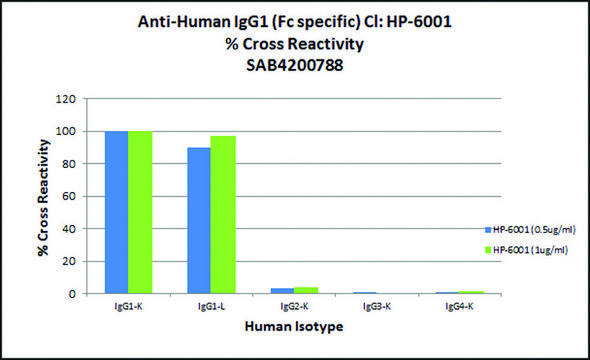F0767
Anti-Human IgG1−FITC antibody, Mouse monoclonal
clone 8c/6-39, purified from hybridoma cell culture
Synonym(s):
Monoclonal Anti-Human IgG1 (Fc specific)
About This Item
Recommended Products
biological source
mouse
Quality Level
conjugate
FITC conjugate
antibody form
purified from hybridoma cell culture
antibody product type
secondary antibodies
clone
8c/6-39, monoclonal
form
buffered aqueous solution
storage condition
protect from light
technique(s)
dot immunobinding: 1:64
particle immunofluorescence: 1:32
isotype
IgG2a
Looking for similar products? Visit Product Comparison Guide
Related Categories
1 of 4
This Item | F4516 | F4891 | SAB4200788 |
|---|---|---|---|
| biological source mouse | biological source mouse | biological source mouse | biological source mouse |
| technique(s) dot immunobinding: 1:64, particle immunofluorescence: 1:32 | technique(s) dot immunobinding: 1:32, particle immunofluorescence: 1:16 | technique(s) dot immunobinding: 1:32, immunohistochemistry (formalin-fixed, paraffin-embedded sections): 1:20, particle immunofluorescence: 1:32 | technique(s) indirect ELISA: 0.5 μg/mL using 1 μg/mL Human IgG1 myeloma protein for coating. |
| antibody form purified from hybridoma cell culture | antibody form purified from hybridoma cell culture | antibody form purified from hybridoma cell culture | antibody form purified from hybridoma cell culture |
| conjugate FITC conjugate | conjugate FITC conjugate | conjugate FITC conjugate | conjugate - |
| isotype IgG2a | isotype IgG1 | isotype IgG1 | isotype IgG2b |
| form buffered aqueous solution | form buffered aqueous solution | form buffered aqueous solution | form buffered aqueous solution |
General description
Application
Flow cytometry/Cell sorting (1 paper)
Biochem/physiol Actions
Physical form
Disclaimer
Not finding the right product?
Try our Product Selector Tool.
Storage Class
10 - Combustible liquids
flash_point_f
Not applicable
flash_point_c
Not applicable
Choose from one of the most recent versions:
Already Own This Product?
Find documentation for the products that you have recently purchased in the Document Library.
Our team of scientists has experience in all areas of research including Life Science, Material Science, Chemical Synthesis, Chromatography, Analytical and many others.
Contact Technical Service





